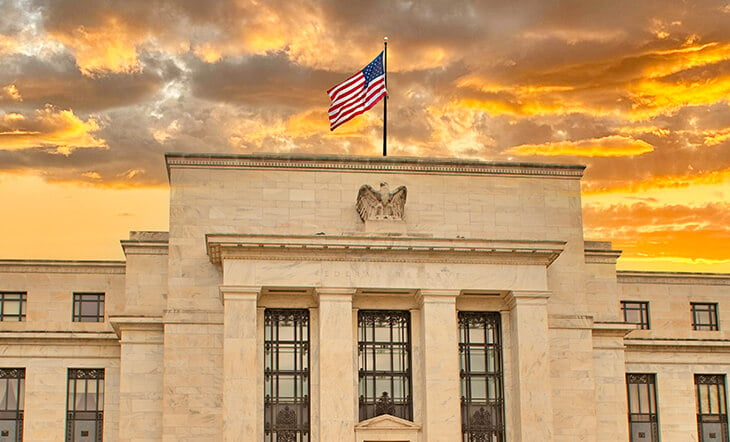The Bulls Keep Running: Why Markets Remain Upbeat
As winter turns to spring, the bulls keep running.
The most recent round of earnings generally delivered good results, with the biggest story being Nvidia continuing to beat analysts’ high expectations. There’s no question that the Tech giant has been an outlier, but it’s an outlier that fits the overarching theme of artificial intelligence (A.I.)—demand for Nvidia’s microchips is there, margins are excellent, and we see no sign of an imminent slowdown. This tells us that American corporations continue to spend and the U.S. remains a very strong market. Quality companies continue to dominate, growing their earnings based on products that are in-demand. That, along with a strong consumer, ultimately why we remain overweight U.S. equities.
American corporations continue to spend and the U.S. remains a very strong market.

Second Verse, Same as the First
Trends from 2023 continue into 2024, with expectations of interest rate cuts from the U.S. Federal Reserve (Fed) getting pushed back further. Meanwhile, the Canadian economy continues to cool and China’s growth struggles persist.
U.S. Outlook
Canada Outlook
Canada’s outlook remains largely the same as recent months. Weak growth continues, with Q4 gross domestic product (GDP) growth clocking in at a subpar 1%. Private sector job growth has also disappointed in recent months. At the same time, a technical recession has been avoided, and growth is tracking positive for Q1. This likely reflects Canada’s economic linkages to the U.S.—a resilient U.S. economy is underpinning Canadian growth. Inflation is still elevated, but the latest report was much more constructive than previous months. We think weak growth and a loosening labour market are important reasons why the Bank of Canada (BoC) will likely cut rates this year. In the near term, however, they’re likely to stay on the sidelines and take their cues from the Fed. If they were to cut before their American counterparts, it would probably be the result of especially ugly growth numbers or bearish developments in the labour market.

International Outlook
In general, we’re seeing early signs that global growth is bottoming, including a greater share of Purchasing Managers’ Indexes (PMIs) rising above 50 (indicating expansion rather than contraction) and trade flows picking up. In particular, leading indicators in the Eurozone and U.K. continue to improve, with both regions also primed for rate cuts given that inflation data is likely to show more meaningful progress beginning in the second quarter.
Weak Chinese growth continues to weigh on the outlook for Emerging Markets (EM). On the macro side, China’s economic outlook remains dour, particularly because there are not yet any signs that its housing market is bottoming. That’s particularly concerning given that stimulus aimed at stemming the bleeding has already been deployed.
Key Risks | BMO GAM house view |
|---|---|
Inflation | • Stronger U.S. growth means a slower path to the Fed’s 2% target and maybe even a small reacceleration of inflation, but not at the level of 2022 |
Interest rates | • Resilient U.S. growth likely means slower, shallower cuts from the Fed |
Recession | • Delayed, but the bears refuse to fold • A recession in 2025 is a possibility |
Consumer | • The U.S. consumer and Canadian consumer are two different species at present • The U.S. consumer is fully employed and doesn’t have to worry about higher rates unless they’re buying a new car or home • For Canadian consumers, mortgage refinancing is the big pain point |
Housing | • The market has come off the lows in both Canada and the U.S. • No longer a drag on the outlook, but delayed rate cuts mean delayed recovery |
Geopolitics | • For the U.S. administration, the goal is to avoid an inflationary escalation • Such an escalation should be considered a low-probability, high-consequence risk |
Energy | • Oil prices are likely the most important part of inflation risk • If there’s another surge in commodity prices driven by geopolitical conflict, that could drive inflation a leg higher |

Asset Classes
Our view is that the market is still looking at three to four cuts from the Fed this year. The one observation to make right now is: if you look at the spread between forecasters who think we’re going to have no cuts to those who believe the economy will decline steeply without five to six cuts, it is probably as wide as it has ever been. Indicators are still pointing to a strong economic environment and we are caught in the middle ground of wanting strong-but-not-too-strong conditions. The market might want rate cuts to come sooner, but be careful what you wish for—if we need more than three or four cuts, it is because something has gone wrong.
Bottom line, we’re bullish on equities. We are cognizant that we’ve had 16 out of 18 weeks of rallies on the S&P 500. It may indeed be time for a little bit of a tactical pull-back, but looking out over the next 12 months, stocks look poised to continue their upward trend.
EQUITIES
- Very Bearish
- Bearish
- Slightly Bearish
- Neutral
- Slightly Bullish
- Bullish
- Very Bullish
FIXED INCOME
- Very Bearish
- Bearish
- Slightly Bearish
- Neutral
- Slightly Bullish
- Bullish
- Very Bullish
CASH
- Very Bearish
- Bearish
- Slightly Bearish
- Neutral
- Slightly Bullish
- Bullish
- Very Bullish

Equity
The market remains the domain of the Magnificent 7 (Apple, Meta Platforms, Alphabet, Microsoft, Tesla, Nvidia and Amazon). They have very fast revenue growth and very high profitability, and those two things put together translates into greater earnings. That has been the case for last 12 months, and the most recent quarter was no different. Our view is that this momentum will eventually fade but it will not be anytime soon. There are going to be pullbacks but the group’s outperformance is a secular theme with staying power—Nvidia, in particular. Other companies may eventually catch up, but for now they have chips that no one else has. We are still in the early innings for AI products. The first wave now is coming from cloud applications and things like ChatGPT. The next is going to be the AI applications for individuals and retail.
That is why regionally we are most constructive on the U.S. market—it is where the Technology-fueled earnings growth is, underpinned by strong GDP growth. A third leg is the policy support. We may see a smaller deficit than last year but we’re still seeing fiscal stimulus. You put all of that together and the U.S. appears to be the most attractive market.
In Canada, we continue to see an economic cooling (but not crashing) which has meant stocks have held up. But on a relative basis, the domestic market is less attractive than that of our U.S. neighbors. Part of that is sector composition; the TSX has a much smaller Technology universe (8.7% vs 30.1% in the S&P 500) and a heavier weight to Materials (10.5% vs 2.3%),1 which is a sector we are less bullish on. We still hold our Canadian bank position. With loan loss provisions probably at a peak, our view is that we are now seeing declining recession risk, a trend we expect to continue throughout 2024.
CANADA
- Very Bearish
- Bearish
- Slightly Bearish
- Neutral
- Slightly Bullish
- Bullish
- Very Bullish
U.S.A.
- Very Bearish
- Bearish
- Slightly Bearish
- Neutral
- Slightly Bullish
- Bullish
- Very Bullish
EAFE
- Very Bearish
- Bearish
- Slightly Bearish
- Neutral
- Slightly Bullish
- Bullish
- Very Bullish
EM
- Very Bearish
- Bearish
- Slightly Bearish
- Neutral
- Slightly Bullish
- Bullish
- Very Bullish

Fixed Income
In general, bonds historically outperform equities and cash in the quarters following the peak of a monetary tightening cycle. But that outperformance is accompanied by—and is, in part, the result of—a slowdown in the economy and equity sell-off. If we are headed into a ‘soft to no landing’ scenario, there will not be the big crunch where you see a very rapid decline in rates. That is in part why we remain neutral (0) on fixed income at the moment.
For the year as a whole, we are bullish on Duration2—however, it is not going to be a straight line down for interest rates. Markets are presently pricing in three to four rate cuts from the Fed, which we think is very plausible. But as of now we are still seeing inflation and growth surprise to the upside. It does not make sense to go overweight duration at this point in time but we’re still strategically bullish. Cuts may come eventually, benefitting long bonds.
We remain neutral (0) on High Yield and Investment Grade bonds as well. Spreads are tight by historical standards, keeping us from going overweight, while we are seeing resilient economic growth. So, we do not see a catalyst for spreads to widen anytime soon—without material spread widening in our in our forecast, we remain neutral (0) on credit across the board.
One theme to watch is the divergence between Canada and U.S. economies, which could eventually create a divergence between the Fed and the BoC. The Canadian central bank historically likes to wait on the Fed to cut first, but if this bifurcation in growth continues, we could see the BoC cut first later this year, and more frequently— especially given the more vulnerable nature of the relatively more indebted Canadian businesses and consumers.
IG CREDIT
- Very Bearish
- Bearish
- Slightly Bearish
- Neutral
- Slightly Bullish
- Bullish
- Very Bullish
HIGH YIELD
- Very Bearish
- Bearish
- Slightly Bearish
- Neutral
- Slightly Bullish
- Bullish
- Very Bullish
EM DEBT
- Very Bearish
- Bearish
- Slightly Bearish
- Neutral
- Slightly Bullish
- Bullish
- Very Bullish
DURATION
- Very Bearish
- Bearish
- Slightly Bearish
- Neutral
- Slightly Bullish
- Bullish
- Very Bullish

Style & Factor
With rate cuts on hold, the focus has changed from multiple expansion to future earnings growth estimates. That, and the comfort afforded from ample free cash flows, are reasons why we favour Quality. From a sector view, we have also shifted to overweight in Healthcare and Industrials.
Given the volatility of markets so far this year, we have seen modest changes in the Style and Factor lens of our house view. In terms of Value versus Growth, there is at present no real driver because we have yet to see an expected impact from a change in interest rate trajectory—if we thought that all of a sudden the market was to reprice to estimates of five to six rate cuts again, we would favour Growth, because of the favourable effect on those multiples. But at this point, we’re not focusing as much on multiples as we are on earnings growth. We like Quality because there is a ton of free cash flow in some of these mega caps. That provides a certain level of downside security, which allows us to stay overweight equities overall.
Looking forward, as we get deeper into this rally, the market is likely to start looking at Value names (in addition to Growth) because of dividends, which typically tend to outperform in a falling rate environment—although we probably prefer to stick with bonds for that play. But dividends are a good hedge in case something goes wrong—you rarely have to apologize for owning dividend-paying stocks. It is this notion that endorses patience with our tilt towards Canadian banks.
VALUE
- Very Bearish
- Bearish
- Slightly Bearish
- Neutral
- Slightly Bullish
- Bullish
- Very Bullish
GROWTH
- Very Bearish
- Bearish
- Slightly Bearish
- Neutral
- Slightly Bullish
- Bullish
- Very Bullish
QUALITY
- Very Bearish
- Bearish
- Slightly Bearish
- Neutral
- Slightly Bullish
- Bullish
- Very Bullish
YIELD
- Very Bearish
- Bearish
- Slightly Bearish
- Neutral
- Slightly Bullish
- Bullish
- Very Bullish

Implementation
Gold is up but a sustained rally will likely require a monetary policy shift to lower interest rates. We have taken positions in derivatives and options to drive returns this month, as well as provide downside protection.

CAD
- Very Bearish
- Bearish
- Slightly Bearish
- Neutral
- Slightly Bullish
- Bullish
- Very Bullish
GOLD
- Very Bearish
- Bearish
- Slightly Bearish
- Neutral
- Slightly Bullish
- Bullish
- Very Bullish
Footnotes
1 Bloomberg, as of March 12, 2024.↩
2 Duration: A measure of the sensitivity of the price of a fixed income investment to a change in interest rates. Duration is expressed as number of years. The price of a bond with a longer duration
would be expected to rise (fall) more than the price of a bond with lower duration when interest rates fall (rise).↩
3 Price/earnings-to-growth ratio: A stock’s price-to-earnings (P/E) ratio divided by the growth rate of its earnings for a specified time period.↩
4 As of March 8, 2024.↩
5 Protective put: A risk-management (hedging) strategy using options contracts that investors use to guard against the loss of owning a stock or asset.↩
Disclosures
The viewpoints expressed by the Portfolio Manager represents their assessment of the markets at the time of publication. Those views are subject to change without notice at any time without any kind of notice. The information provided herein does not constitute a solicitation of an offer to buy, or an offer to sell securities nor should the information be relied upon as investment advice. Past performance is no guarantee of future results. This communication is intended for informational purposes only.
Commissions, management fees and expenses all may be associated with investments in exchange traded funds. Please read the ETF Facts or prospectus of the BMO ETFs before investing. Exchange traded funds are not guaranteed, their values change frequently and past performance may not be repeated. For a summary of the risks of an investment in the BMO ETFs, please see the specific risks set out in the BMO ETF’s prospectus. BMO ETFs trade like stocks, fluctuate in market value and may trade at a discount to their net asset value, which may increase the risk of loss. Distributions are not guaranteed and are subject to change and/or elimination. BMO ETFs are managed by BMO Asset Management Inc., which is an investment fund manager and a portfolio manager, and a separate legal entity from Bank of Montreal.
Any statement that necessarily depends on future events may be a forward-looking statement. Forward-looking statements are not guarantees of performance. They involve risks, uncertainties and assumptions. Although such statements are based on assumptions that are believed to be reasonable, there can be no assurance that actual results will not differ materially from expectations. Investors are cautioned not to rely unduly on any forward-looking statements. In connection with any forward-looking statements, investors should carefully consider the areas of risk described in the most recent simplified prospectus.
This article is for information purposes. The information contained herein is not, and should not be construed as, investment, tax or legal advice to any party. Investments should be evaluated relative to the individual’s investment objectives and professional advice should be obtained with respect to any circumstance.
BMO Global Asset Management is a brand name under which BMO Asset Management Inc. and BMO Investments Inc. operate.
“BMO (M-bar roundel symbol)” is a registered trademark of Bank of Montreal, used under licence.



